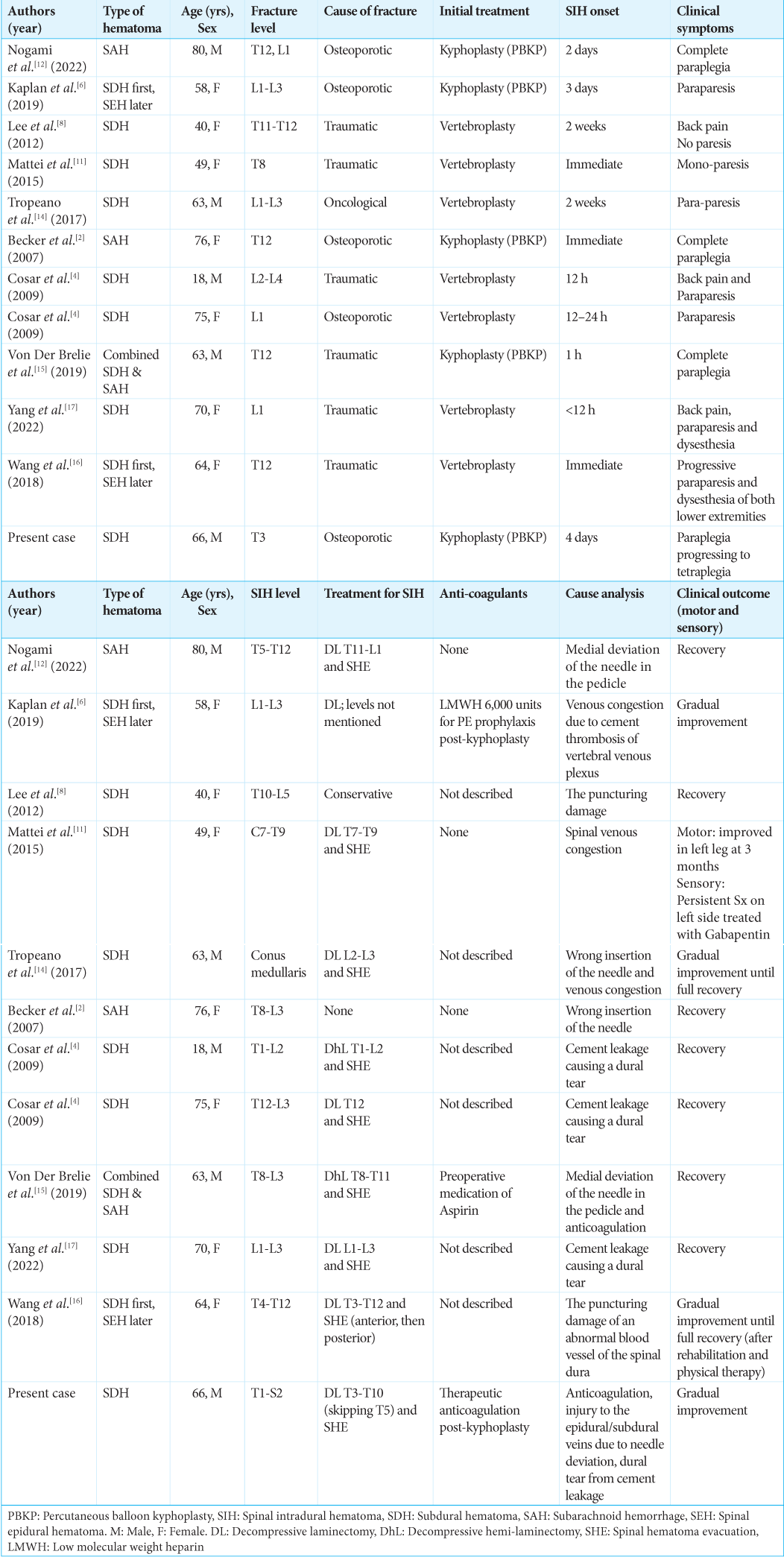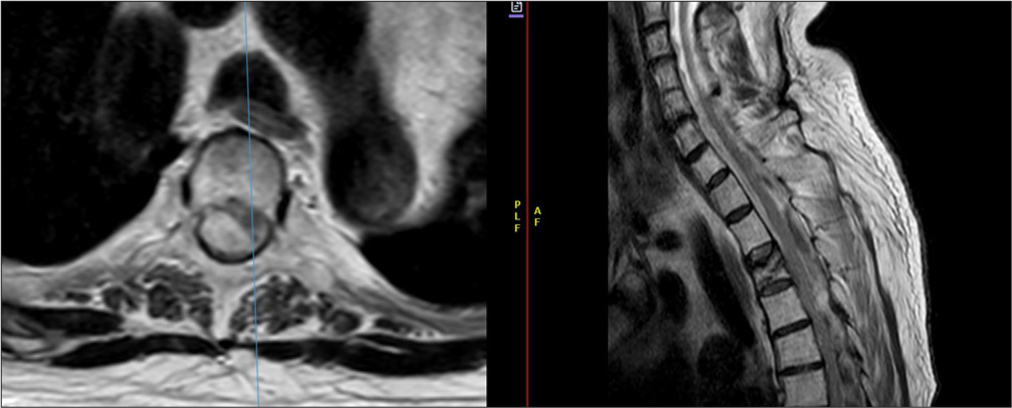- Faculty of Medicine, American University of Beirut, Beirut, Lebanon
- Division of Neurosurgery, American University of Beirut Medical Center, Beirut, Lebanon
- Division of Orthopedic Surgery, American University of Beirut Medical Center, Beirut, Lebanon
Correspondence Address:
Houssein Darwish, Division of Neurosurgery, American University of Beirut Medical Center, Beirut, Lebanon.
DOI:10.25259/SNI_370_2025
Copyright: © 2025 Surgical Neurology International This is an open-access article distributed under the terms of the Creative Commons Attribution-Non Commercial-Share Alike 4.0 License, which allows others to remix, transform, and build upon the work non-commercially, as long as the author is credited and the new creations are licensed under the identical terms.How to cite this article: Ibrahim Mrad1, Mohamad El Houshiemy2, Sarah Kawtharani2, Wael Ali Shouman1, Suhyl Lakkis3, Houssein Darwish2. Delayed-onset spinal subdural hematoma after kyphoplasty. 23-May-2025;16:197
How to cite this URL: Ibrahim Mrad1, Mohamad El Houshiemy2, Sarah Kawtharani2, Wael Ali Shouman1, Suhyl Lakkis3, Houssein Darwish2. Delayed-onset spinal subdural hematoma after kyphoplasty. 23-May-2025;16:197. Available from: https://surgicalneurologyint.com/surgicalint-articles/delayed-onset-spinal-subdural-hematoma-after-kyphoplasty/
Abstract
Background: Spinal subdural hematoma (SDH) is a very rare complication of percutaneous balloon kyphoplasty. Here, a 66-year-old male developed delayed-onset spinal SDH following kyphoplasty.
Case Description: A 66-year-old male with a history of atrial fibrillation on Eliquis developed a SDH on day 4 following a T3 single-level kyphoplasty for an osteoporotic compression fracture. The patient presented with progressive lower extremity motor/sensory paralysis that eventually ascended to the cervical region. The magnetic resonance (MR) imaging revealed a large dorsal subdural hematoma extending from T1 to S2. The patient underwent a decompressive laminectomy for hematoma to remove cement fragments and repair a dural tear. Postoperatively, the patient partially recovered sensation but no motor function and expired in the intensive care unit due to major comorbid factors.
Conclusion: SDH is a potentially serious risk of performing a kyphoplasty. This is particularly true for patients on anticoagulants who should be stringently monitored with MR if indicated to avoid a major postoperative hemorrhage and paralysis.
Keywords: Cement leakage, Dural tear, Osteoporosis, Percutaneous kyphoplasty, Spinal subdural hematoma
INTRODUCTION
The risk of major adverse events (AE) associated with kyphoplasty is estimated at 4.9%.[
CASE PRESENTATION
A 66-year-old male with atrial fibrillation on Eliquis (Apixaban) complained of severe back pain for 2 weeks. When the magnetic resonance imaging (MRI) showed a vertebral compression fracture at the T3 level with a 16% loss of height, the patient underwent a bilateral T3 percutaneous balloon kyphoplasty (PBKP) [
DISCUSSION
There are very few cases of SDH following PBKP;[
CONCLUSION
This case highlights the critical importance of closely monitoring patients who have undergone kyphoplasty for post-procedure hemorrhages (i.e., including subdural hematomas) especially where anticoagulation has been reinstituted.
Ethical approval:
The Institutional Review Board has waived the ethical approval for this study.
Declaration of patient consent:
The authors certify that they have obtained all appropriate patient consent.
Financial support and sponsorship:
Nil.
Conflicts of interest:
There are no conflicts of interest.
Use of artificial intelligence (AI)-assisted technology for manuscript preparation:
The authors confirm that there was no use of artificial intelligence (AI)-assisted technology for assisting in the writing or editing of the manuscript and no images were manipulated using AI.
Disclaimer
The views and opinions expressed in this article are those of the authors and do not necessarily reflect the official policy or position of the Journal or its management. The information contained in this article should not be considered to be medical advice; patients should consult their own physicians for advice as to their specific medical needs.
References
1. Abdelrahman H, Siam AE, Shawky A, Ezzati A, Boehm H. Infection after vertebroplasty or kyphoplasty. A series of nine cases and review of literature. Spine J. 2013. 13: 1809-17
2. Becker S, Meissner J, Tuschel A, Chavanne A, Ogon M. Cement leakage into the posterior spinal canal during balloon kyphoplasty: A case report. J Orthop Surg (Hong Kong). 2007. 15: 222-5
3. Burton AW. Vertebroplasty and kyphoplasty: Case presentation, complications, and their prevention. Pain Med. 2008. 9: S58-64
4. Cosar M, Sasani M, Oktenoglu T, Kaner T, Ercelen O, Kose KC. The major complications of transpedicular vertebroplasty. J Neurosurg Spine. 2009. 11: 607-13
5. Grelat M, Le Van T, Fahed E, Beaurain J, Madkouri R. Rare complication of percutaneous technique: Intradural cement leakage and its surgical treatment. World Neurosurg. 2018. 118: 97
6. Kaplan N, Akyuva Y, Güven G. A rare and unusual complication of kyphoplasty: A case report of spinal subdural hemotoma. J Acad Res Med. 2019. 9: 107-10
7. Kim HJ, Zuckerman SL, Cerpa M, Yeom JS, Lehman RA, Lenke LG. Incidence and risk factors for complications and mortality after vertebroplasty or kyphoplasty in the osteoporotic vertebral compression fracture-analysis of 1,932 cases from the american college of surgeons national surgical quality improvement. Glob Spine J. 2022. 12: 1125-34
8. Lee KD, Sim HB, Lyo IU, Kwon SC, Park JB. Delayed onset of spinal subdural hematoma after vertebroplasty for compression fracture: A case report. Korean J Spine. 2012. 9: 285-8
9. Lee YH, Chen PQ, Wu CT. Delayed-onset radiculopathy caused by a retropulsed bone fragment after percutaneous kyphoplasty: Report of four cases and literature review. BMC Musculoskelet Disord. 2022. 23: 529
10. Lu J, Zhang W, Jiang G, Luo K, Cai K, Zhang K. Risk factors for spinal subdural hematoma after minimally invasive transforaminal lumbar interbody fusion (MI-TLIF): A multivariate analysis. BMC Musculoskelet Disord. 2023. 24: 939
11. Mattei TA, Rehman AA, Dinh DH. Acute spinal subdural hematoma after vertebroplasty: A case report emphasizing the possible etiologic role of venous congestion. Global Spine J. 2015. 5: e52-8
12. Nogami R, Matsuoka H, Ohashi S, Narikiyo M, Nagasaki H, Tsuboi Y. Spinal subarachnoid hemorrhage after percutaneous kyphoplasty: A case report and literature review. J Spine Surg. 2022. 8: 491-6
13. Robinson Y, Tschöke SK, Stahel PF, Kayser R, Heyde CE. Complications and safety aspects of kyphoplasty for osteoporotic vertebral fractures: A prospective follow-up study in 102 consecutive patients. Patient Saf Surg. 2008. 2: 2
14. Tropeano MP, La Pira B, Pescatori L, Piccirilli M. Vertebroplasty and delayed subdural cauda equina hematoma: Review of literature and case report. World J Clin Cases. 2017. 5: 333-9
15. Von Der Brelie C, Fiss I, Rohde V. Multilevel spinal combined subdural/subarachnoid hemorrhage resulting in paraplegia: An unusual complication of kyphoplasty. J Neurol Surg A Cent Eur Neurosurg. 2019. 80: 220-2
16. Wang X, Peng Y, Qiu J, Huang D. Spinal subdural and epidural hematomas after vertebroplasty for compression fracture: A case report. Spinal Cord Ser Cases. 2018. 4: 87
17. Yang HC, Liu HW, Lin CM. Spinal subdural hematoma from a ventral Dural puncture after percutaneous vertebroplasty: Illustrative case. J Neurosurg Case Lessons. 2022. 3: CASE21594
18. Zou P, Gong HL, Wei JM, Wei DM, Qian LX, Liu P. Spinal epidural hematoma after percutaneous kyphoplasty: Case report and literature review. J Pain Res. 2020. 13: 2799-804








